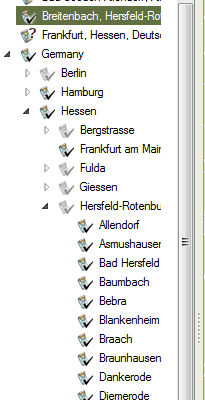I've run into this same issue in both Family Tree Maker 2019 and RootsMagic 7/8. Both seem to use the same database of locations, as I find the same places missing in both programs.
When resolving place names, I know that you can 'ignore' a specific place and it'll be removed from the list of 'unidentified' places. However, that just papers over the display, while keeping the problems:
- The place does not get categorized with other places in that region. Here's an example; notice that Breitenbach is marked as ignored, which removes the "?" icon, but the village remains at the top-most level in the list of places, rather than moving into the proper place within Hersfeld-Rotenburg in the tree:
- Neither program will suggest those 'ignored' places when you're entering another fact for that place. Indeed, going with the same example, FTM2019 suggests both 'Breitenbach am Herzberg' and 'Breitenbach, Kassel', but not 'Breitenbach, Hersfeld-Rotenburg'. (Both are nearby, but are completely different villages.)
In addition to the randomly missing villages, nearly every German Hof I've tried is not in the databases.
I've run into the same issue with Canadian and US locations. In Canada, I've found a quite large number of towns in Nova Scotia are missing. In the US, I have at least a few dozen townships and modern-day ghost-towns that similarly are not in the databases.
This shouldn't be too big of a problem to fix; I'd happily add the places to the local copy of the database. However, how can that be done?
Clarification of the question:
Rootsmagic handles locations not in the master local database by letting you add a location that, once added, acts essentially the same as one from that database. (Rootsmagic only annoys me because you have to identify each location one at a time.) It'd be nice, however, to be able to add directly to that database, so I can reuse those same missing locations between different rmgc files, without having to re-enter them each time.
In FTM2019, you resolve unidentified locations in bulk, which is a huge time saver, using "Resolve All Place Names". However, as described in the question, FTM2019 does not allow you to add a location that is handled on par with locations from its local master database. All locations start as "unidentified". You then can either pick a location from within its local master database, or click the checkbox to "ignore" that location.
Continuing with the example of "Breitenbach, Hersfeld-Rotenburg, Hessen, Germany", this is a village not in the FTM2019 database. The four closest villages are:

- North: Bebra, Hersfeld-Rotenburg, Hessen, Germany - in the database
- South: Blankenheim, Hersfeld-Rotenburg, Hessen, Germany - in the database
- West: Lüdersdorf, Hersfeld-Rotenburg, Hessen, Germany - in the database
- East: Weiterode, Hersfeld-Rotenburg, Hessen, Germany - in the database
All 5 towns are equal in the number of "place levels". All five are 500+ years old. All five still are inhabited today. All five were listed in the Meyers Gazetteer, as well as within Arcinsys, the place authorities you'd likely consider for either the late 1800s, or for today.
However, of the five, one is not in the master database of either FTM2019 or RootsMagic. As described above, for RootsMagic, it's an annoyance, but a one-time pain per rmgc file. For FTM2019, however, "unidentified" locations not in the database cannot be created, only "ignored". Thus to restate this question, how can the master database itself be edited (especially for FTM2019)?

